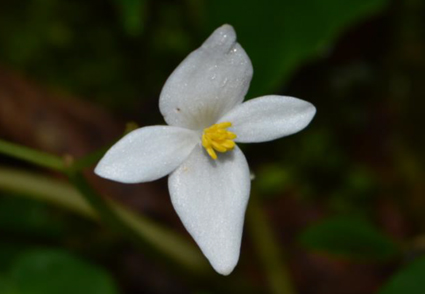Abstract
Begonia tamoiana is a new species endemic to Brazilian Atlantic Rainforest, a biome rich in endemism and species diversity, and it is described and illustrated herein. Begonia tamoiana is morphologically similar to B. magdalenensis but differs in having abaxial leaf blades with simple trichomes throughout (vs. 2-branched trichomes throughout) and ovate wings capsule (vs. triangular). A description, ecological comments, illustrations, color photographs, and a provisional IUCN conservation assessment of this species are provided. Begonia tamoiana is preliminarily classified as Vulnerable (VU) due to its very small populations and restricted distribution.
References
- Brade, A.C. (1945) Begônias novas do Brasil III. Rodriguésia 18: 17–22.
- Candolle, A., de (1859) Mémoire sur la famille du Begoniacées. Annales des Sciences Naturelles Botanique Sér. 4, 11: 93–149.
- Carauta, J.P.P. (1973) The text of Vellozo’s Flora Fluminensis and its effective date of publication. Taxon 22 (2–3): 281–284. https://doi.org/10.2307/1218138
- Fundación Vida Silvestre Argentina and WWF (2017) State of the Atlantic Forest: Three Countries, 148 Million People, One of the Richest Forests on Earth. Puerto Iguazú, Argentina.
- Hughes, M., Moonlight, P.W., Jara-Muñoz, A., Tebbitt, M.C., Wilson, H.P. & Pullan, M. (2015–onwards) Begonia Resource Centre. Available from: http://padme.rbge.org.uk/begonia/ (accessed 2 July 2024)
- IUCN Standards and Petitions Committee (2022) Guidelines for Using the IUCN Red List Categories and Criteria. Version 15.1. Prepared by the Standards and Petitions Committee. Available from: https://www.iucnredlist.org/documents/RedListGuidelines.pdf (accessed 28 May 2024)
- Jacques, E.L. (2018) Re-establishment of Begonia oxyphylla (Begoniaceae), a species from the coastal forests of Brazil. Phytotaxa 381 (1): 22–26. https://doi.org/10.11646/phytotaxa.381.1.6
- Jacques, E.L. (2022) Three Brazilian species of Begonia (Begoniaceae) from the state of Rio de Janeiro, Brazil. Phytotaxa 561 (2): 138–150. https://doi.org/10.11646/phytotaxa.561.2.2
- Jacques, E.L. (2024) Begoniaceae in Flora e Funga do Brasil. Jardim Botânico do Rio de Janeiro. Available from: https://floradobrasil.jbrj.gov.br/FB59 (accessed 4 July 2024)
- Joly, C.A., Metzger, J.P. & Tabarelli, M. (2014) Experiences from the Brazilian Atlantic Forest: Ecological findings and conservation initiative. New Phytologist 204 (3): 459–473. http://doi.org/10.1111/ nph.12989
- Linnaeus, C. (1753) Species Plantarum, vol. 2. Impensis Laurentii Salvii, Holmiae, pp. 561–1231.
- Moonlight, P.W. & Jacques, E.L. (Submitted) The identity and typification of the begonias from Vellozo’s Flora Fluminensis. Edinburgh Journal of Botany.
- Moonlight, P.W., Baldaszti, L., Cardoso, D., Elliott, A., Särkinen, T. & Knapp, S. (2024) Twenty years of big plant genera. Proceedings of the Royal Society B 291: 20240702. https://doi.org/10.1098/rspb.2024.0702
- Mori, S.A. & Smith, N.P. (2012 onward) The New York Botanical Garden’s glossary for vascular plants. Virtual Herbarium of The New York Botanical Garden, Bronx, New York. Available from: https://sweetgum.nybg.org/science/glossary/ (accessed 28 May 2024)
- Pastore, J.F.B. (2013) A review of Vellozo’s names for Polygalaceae in his Flora Fluminensis. Phytotaxa 108 (1): 41–48. http://dx.doi.org/10.11646/phytotaxa.108.1.2
- Pastore, J.F.B., Mota, M., Menezes, H.F.d. & Trovó, M. (2022) Vellozo’s Florae Fluminensis: A new assessment of the São Paulo part of his collecting itinerary, its vegetation, and species list. Taxon 70 (5): 1078–1095 https://doi.org/10.1002/tax.12509
- Paxton, J. (1846) Begonia ramentacea. Paxton’s Magazine of Botany 12: 73.
- Radford, A.E., Caddell, G., Doyle, J. Qualls, F. Radford, L.S, Barkley, T.M., Isely, D. & Simpson, M.G. (1986) Fundamentals of Plant Systematics. Harper & Row Publ., New York, 498 pp.
- Raddi, G. (1820) Quaranta piante nuove del Brasile. Memorie di matematica e di fisica della Societ`a italiana delle Scienze 18: 408.
- Stehmann, J.R., Forzza, R.C., Sobral, M. & Kamino, L.H.Y. (2009) Gimnospermas e Angiospermas. In: Stehmann, J.F., Forzza, R.C., Salino, A., Sobral, M., Costa, D.P. & Kamino, L.H.Y. (eds.) Plantas da Floresta Atlântica. Jardim Botânico do Rio de Janeiro, Rio de Janeiro, 505 pp.
- Thiers, B. (2024) [continuously updated] Index Herbariorum: A global directory of public herbaria and associated staff. Available from: http://sweetgum.nybg.org/science/ih/ (accessed 4 July 2024)


